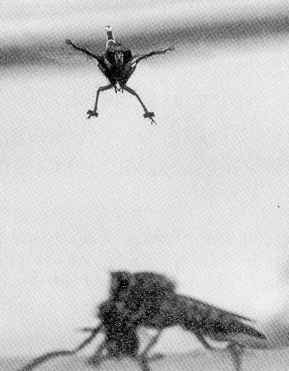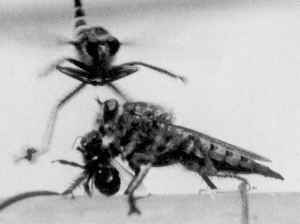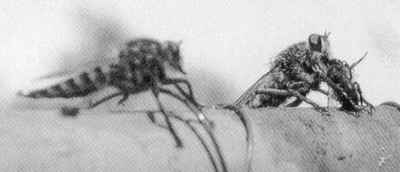 |
 |
 |
| Fig. 1-3: Promachus latitarsatus,courtship display. | ||
The courtship display of a Promachus latitarsatus is described for the first time. This species belongs to a group of which the males have lateral fringes of long, flattened bristles on the hind tarsus. These are a significant signal for the female during the hover flight ahead of the female.
Das Balzverhalten von Promachus latitarsatus wird erstmals beschrieben. Das Männchen präsentiert während seines Schwebfluges vor dem ansitzenden Weibchen seine auffallend gestalteten Hintertarsen. Diese sind mit senkrecht abstehenden Borsten versehen und dienen dem Weibchen als Erkennungsmerkmal.
Key words: Insecta, Diptera, Asilidae, Promachus, courtship, Canary Islands
During a trip to the Island of Gran Canaria (Canary Islands) some robber flies could be observed. Until today 26 specimens are known on the Islands, 19 of them are endemic species (Weinberg & Baez, 1991, 1992a, b) [note: Hradský & Geller-Grimm (1996)].
Particulary it was very interesting to see the courtship display of Promachus latitarsatus (Macquart in Wepp & Berthelot, 1839). The male initiated the courtship by hovering ahead of a female, which perched and sucking out a bee. During this hovering the male fully extended all legs spread apart in a distance of 5 - 10 cm (Fig. 1). In that manner the lateral fringes of long, flattened bristles on the hind tarsi are a distinct signal for the female. In addition the male lifted up his abdomen so that the white haired genitalia can be a second sign. After some seconds the male came up (Fig. 2) and finally sat down near the female (Fig. 3). At that moment the flies were disturbed and both flew away. Mating could not be observed.
 |
 |
 |
| Fig. 1-3: Promachus latitarsatus,courtship display. | ||
We know that robber flies have an excellent optical system and most of species perform different courtship displays. Already Frey (1937) examined the 5 Promachus species on the Canary Islands. He found a distinctive mark in the kind of bristles on the hind tarsi of the males. P. latitarsatus has long black bristles only on the 2. - 4. tarsomeresi, which stand in a right angle to the leg. In contrast P. vexator has lateral black bristles on the 2. - 5. tarsomeres which stand in an angle of 30ø for example. Other Promachus species are distinguished by patches of colored hairs on the first tergits. In general the females have small distinguishing features, they are a little bit different in the color of hairs and tomentum and it is unknown how the males identify them. But on the Canary Islands all five species live seperately on different islands and therefore confusion seems to be impossible.
Until today the courtship performance of Promachus has described for three species only. Hull (1942) describes a hovering male of Promachus bastardii (Macquart, 1838) in Mississippi. Lavigne & Holland (1969) proved a similar hover courtship for Promachus dimidiatus Curran, 1927 in Wyoming, but the species can mate without courtship display just as well. Daniels (1976) reports about the courtship of a Promachus species in Australia. During the hovering, this male folds his first two pairs of legs against the thorax, while the hind legs extend along and below the body and the white hairs on the tibia form a species recognition mark.
We like to express our thanks to Mrs. Dr. M. Weinberg (Roumania) and Mr. M. Hradský (Czech Republic) for sending some of the cited literature.
Last saved May 05 1998
© F. Geller-Grimm & M. Geisthardt